Dangerous Goods
- Research has revealed that approximately 40-50% of the cargo carried on various transport modes fall directly under the category of dangerous goods.
- Also referred to as hazardous materials (HAZMAT or HazMat).
- Dangerous goods include materials that are radioactive, flammable, explosive, corrosive, oxidizing, asphyxiating, bio hazardous, toxic, pathogenic, or allergenic.
Importance of Awareness of Dangerous Goods to a Freight Forwarder
- The forwarder shoulders a lot of responsibility thus must acquire from the customer/shipper ALL the relevant information in compliance with relevant rules and regulations prior to proceeding with execution of the transportation.
- Relevant certificates and shipper’s declaration must be correctly filled out and signed by the shipper.
- Marking and Labeling of the cargo must be correctly done using the correct placards.
Rules and Regulations Governing Dangerous Goods by Transport Mode
The United Nations Economic and Social Council issues the UN Recommendations on the Transport of Dangerous Goods, which form the basis for most regional and national regulatory schemes
- AIR TRANSPORT IATA/ICAO DGR
International Air Transport Association Dangerous Goods Regulations which are revised periodically.
- SEA/OCEAN TRANSPORT IMDG
International Maritime Dangerous Goods Code which was published by International Maritime Organization.
- ROAD TRANSPORT SDR/ADR (Europe)
- RAILWAY TRANSPORT RSD/ RID (Europe)
Organization for International Carriage by Rail
Factors to Consider When Transporting Dangerous Goods
In order to have safe transport of dangerous goods the following important issues must be taken into account:
- Classification of dangerous goods
- Safety packing of dangerous goods
- Hazard warning signs
- Documentation
- Safe transport operations
- Safe storage
- Segregation of incompatible goods
Classification of Dangerous Goods
The process of classification of Dangerous Goods involves several steps
STEP 1:
- Assignment of goods to hazard classes according to defined criteria.
- Generally dangerous goods are classified under Hazard Classes 1-9 (as illustrated below).
Class Description of cargo
- Class 1: Explosive substances and articles
- Class 2: Compressed, liquefied or dissolved gases
- Class 3: Flammable liquids
- Class 4.1: Flammable solids, self-reactive substances
- Class 4.2: Spontaneous combustible substances
- Class 4.3: Water-reactive substances
- Class 5.1: Oxidizing substances
- Class 5.2: Organic peroxides
- Class 6.1: Toxic substances
- Class 6.2: Infectious substances
- Class 7: Radioactive material
- Class 8: Corrosive substances
- Class 9: Miscellaneous dangerous substances and articles.
Hazmat Classification System
- 1.1 Mass explosion hazard
- 1.2 Projection hazard
- 1.3 Predominately a fire hazard
- 1.4 No significant blast hazard
- 1.5 Very insensitive explosives; blasting agents
- 1.6 Extremely insensitive detonating substances
- 2.1 Flammable gas
- 2.2 Non-Flammable compressed gas
- 2.3 Poisonous gas
Class 3: Flammable and Combustible Liquids
- 4.1 Flammable solid
- 4.2 Spontaneously combustible material
- 4.3 Dangerous when wet material
Class 5: Oxidizing Agents & Organic Peroxides
- 5.1 Oxidizer
- 5.2 Organic peroxide
Class 6: Toxic & Infectious Substances
- 6.1 Poisonous materials
- 6.2 Infectious substance (Etiologic agent)
Classification of Dangerous Goods
STEP 2: Clear identification by UN-number
- UN-number has four digits where by class 1 starts with zero.
- Single entries for well-defined substances e.g. UN1090 acetone.
- Generic entries for well-defined substance group e.g. UN1133 adhesives.
- Specific N.O.S. entries covering a substance group e.g. UN1477 nitrates, Inorganic N.O.S.
STEP 3: Frequently transported goods mentioned by name in dangerous goods list.
STEP 4: Generic entries (N.O.S – shipping name) to assign goods not listed by name.
- For proper description of Dangerous goods, the following must be noted
UN Model Regulations
- Developed by UN economic and social council – committee of experts on the transport of dangerous goods.
- Addressed to government and international organizations concerned with regulations for dangerous goods.
- Not applicable for bulk transport of dangerous goods in ships.
- Basic scheme or provisions allowing uniform development of dangerous goods regulations for various modes of transport.
- Contribution to worldwide harmonization of transport regulations.
Subdivision of Class 1
- Subdivision according to the extent of hazard:
- Mass explosive substances and articles.
- Substances and articles with projection hazard, not being mass explosive.
- Substances and articles which have a fire hazard and a minor blast hazard or a minor projection hazard or both, but not a mass explosion hazard.
- Substances and articles which present no significant hazard.
- Very insensitive mass explosive substances.
- Extremely insensitive articles which do not have a mass explosion hazard.
- Subdivision according to the extent of hazard:
Compatibility group class 1
- Assignment according to the nature of the substance or article.
- Designated to determine permitted mixed loading
- Following compatibility groups exist: A, B, B, D, E, F, G, H, J, K, L, N, S.
Subdivision of Class 2
- Flammable gases
- Nonflammable, nontoxic gases
- Toxic gases
Subdivision of Class 4.1
- Flammable solids
- Self-reactive solids and liquids
- Desensitized explosive substances.
Subdivision of class 7
- Excepted package
- Category I – low radiation level (<0.005mSv/h on the packaging)
- Category II – medium radiation level (<0.5mSv/h on the packaging)
- Category III – high radiation level (>0.5 mSv/h on the packaging)
Classification of substances not listed by name
According to the properties:
- Physical state (solid, liquid, gaseous)
- Chemical formulation (e.g. alcohol, ketone, cyanide)
- Explosive properties
- Flammability
- Liability to spontaneous combustion
- Gas evolution upon reaction with water.
- Oxidizing properties
- Toxicity
- Corrosive effects
Effect of the marine environment assigned by the shipper to the n.o.s. (not otherwise specified) entry which most exactly describes the properties.
Classification of substances listed by name
- Special requirements
- Explosive substances and articles
- Self-reactive substances
- Organic peroxides
Subsidiary risks
- Substances with multiple hazards
- Mixtures of substances with different hazards
UN – Members
- Four digits (Class 1 starts with “O”)
- Assignment for specific substances or specific groups of substances
- This is assigned by United Nations Committee of Experts on the Transport of Dangerous Goods.
Classification of substances listed by name
- Special requirements
- Explosive substances and articles
- Self-reactive substances
- Organic peroxides
Subsidiary risks
- Substances with multiple hazards
- Mixtures of substances with different hazards
UN – Members
- Four digits (Class 1 starts with “O”)
- Assignment for specific substances or specific groups of substances
- This is assigned by United Nations Committee of Experts on the Transport of Dangerous Goods.
UN Model Regulations
No. | CLASS/DIVISION | GROUP I | GROUP II | GROUP III |
1 | 3 Liquid or viscous substances | – | V | V |
2 | 4.1 Flammable Solids | – | V | V |
3 | 4.2 Spontaneous combustible substances | – | V | V |
4 | 4.3 Water reactive substances | – | V | V |
5 | 5.1 Oxidizing Substances | V | V | V |
6 | 6.1 Toxic Substances | V | V | V |
7 | 8 Corrosive Substances | V | V | V |
Identification Packing Code:
Unique or External Packing:
- A three numbers code used to identify packing other than internal is done as follows:
- An Arabic number indicating the type of packing
- Followed by a capital letter indicating the nature of the item
- Followed, if necessary, by an Arabic number indicating the category of packing within the type to which it belongs to.
- For the mixed packing, two capital letters are used to indicate the nature of items used: The first letter the item contained in, and the second indicating the nature of the container. For the mixed packing, only the code of the container is used.
- Gases in bulk according to Solas chapter vii part ‘c’
Inner Packaging:
- A three or four numbers code is used to identify the inner packing;
- Capital letters <<IP>> meaning <<Inner Packaging>> or internal packing;
- Followed by an Arabic number identifying the type of packing;
- And, if necessary, by a capital letter indicating the category of packing to which it belongs.
Identification of Dangerous Goods
- UN – Number
- Proper shipping name
- Supplemented by chemical name (if applicable)
- Class
- Subsidiary risks (if applicable)
- Packaging Group (when assigned)
Examples of proper dangerous goods description
- UN 1830 SULPHURIC ACID, class 8, II
- UN 2902 PESTICE, LIQUID, TOXIC N.O.S. (draxozolon) class 6.1, II
- UN 1902 ACROLEIN, stabilized, class 6.1 (3), I
- UN 1992 FLAMMABLE LIQUID, TOXIC, N.O.S. (ethanol and toluidine), class 3 (6.1), II.
Selection of containments
- Packing instruction for each UN – Number in dangerous goods list
- Packing instructions for:
- Regular packaging
- Large packaging
- Intermediate bulk containers (IBC)
- Tanks
- Bulk containers
Types of containment
- Regular packaging (Volume max. 450L)
- Large packaging (volume max. 3000l) for inner packaging)
- IBC (volume max. 3000l) for liquids or solid bulk.
- Tank (volume not restricted) for liquid or solid bank.
- Bulk container (for low hazard goods only)
Chemical and Physical Properties of dangerous goods
- Dangerous goods are classified based on chemical and physical properties and how the same react in other substances. The major grouping is as follows:
Class 1: Explosives
- Division 1.1: Substances and articles which have a mass explosion hazard
- Division 1.2: Substances and articles which have a projection hazard but not a mass explosion Hazard
- Division 1.3: Substances and articles which have a fire hazard and either a minor blast hazard or a minor projection hazard or both, but not a mass explosion hazard
- Division 1.4: Substances and articles which present no significant hazard
- Division 1.5: Very insensitive substances which have a mass explosion hazard
- Division 1.6: Extremely insensitive articles which do not have a mass explosion hazard.
Reading a Label
Labels go on packages
Each label (and placard)has its own:
- Color
- Symbol
- Wording or ID number
- UN hazard class number
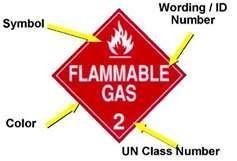

Class 1: Explosives
Hazard: rapid rate of pressure rise within short time interval
Examples/hazard:
1.1 TNT, mass explosion
1.2 Detonating cord,
projection hazard,
fragments
1.3 Ammunition, fire,
blast or projection
hazard


1.4 Detonating material, minor explosion hazard
1.5 Blasting agents i.e. ANFO (ammonium nitrate and fuel oil mixtures), mass explosion but very insensitive
1.6 Articles, explosive, extremely insensitive
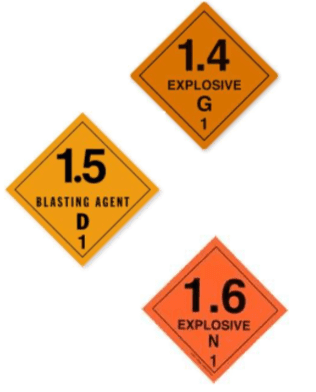

Class 2: Gases
2.1 Flammable, propane
2.2 Non-flammable, nitrogen, argon, helium
2.3 Poison (toxic), chlorine and hydrogen cyanide; may also have other hazardous properties
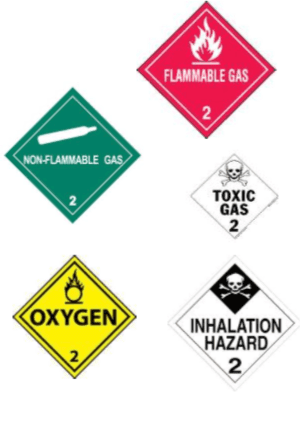

Class 3: Flammable/Combustible Liquids
Class 3: Flammable liquids may easily ignite (e.g., gasoline and alcohol)
Class 3: Combustible liquids will not readily ignite and may have to be pre-heated (e.g., kerosene and fuel oil)
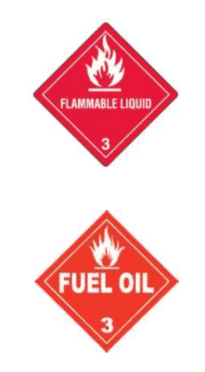

Class 4: Flammable Solids
4.1 Burn readily and violently; aluminum powder, coated
4.2 Air-reactive, barium alloys, pyrophoric
4.3 Water-reactive with possible poisonous fumes, barium
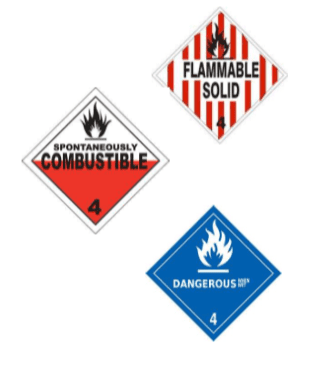

Class 5: Oxidizer
5.1 Provide oxygen to the combustion process; potassium superoxide
5.2 Also enhances burning and may be heat, shock and friction sensitive; organic peroxide
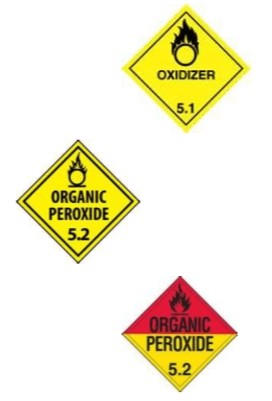

Class 6: Poison (Toxic)
6.1 Solid or liquid state with poisonous properties (e.g., chloropicrin)
6.2 Infectious substances like biological and organic materials that may cause disease (e.g., live micro-organisms) inhalation hazard also used for materials listed as poison inhalation hazard (PIH)


Class 7: Radioactive
Used to denote emitters of alpha or beta particles of radiation or gamma radiation
- Radioactive I:
Least hazardous
- Radioactive II:
Moderate hazard
- Radioactive III:
More serious hazard comparatively


Class 8: Corrosive
Damage to skin; may corrode steel or aluminum as well as some may be water-reactive
Nitric acid and hydrochloric acid in addition to sodium hydroxide are examples
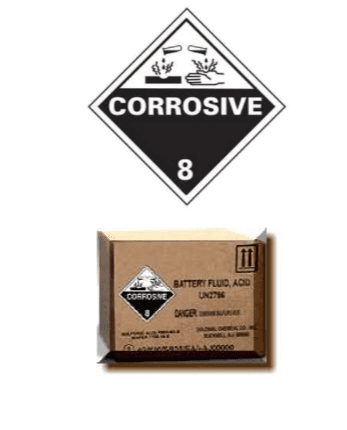

Class 9: Miscellaneous
Mildly hazardous and may be physically solid, liquid or gas state
Extremely annoying due to producing vapors which may interfere with flight crews
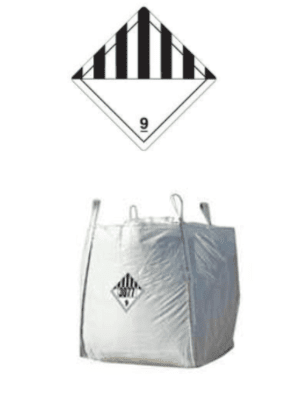

Marking and Labelling of Dangerous Goods
Marking:
- The consignor is responsible for all marks and labels which have to appear on each package of dangerous cargo or over-packing gathering dangerous cargo packages;
- There are two types of marks;
- Marks identifying the mode or specification of packing without considering its use for a certain consignment (done by a manufacturer).
- Marks identifying the use of a special packing for a special consignment (done by the consignor).
Labeling:
- The alphabetical list of dangerous goods gives the labels of danger to be fixed on the parcels.
- The label corresponding to the primary risk first is clearly indicated for each item or substance, then, for items or substances presenting a subsidiary risk, the label or labels corresponding to that risk.
- Only the labels indicating a primary danger must indicate, on the down corner, the class or division number.
- The minimum size of labels are of 100 * 100 mm for all classes and division of danger, while the minimum size of figures indicating the divisions 1.4, 1.5 and 1.6 is of 30 mm of high for 5 mm of large.
Special Requirements of Transportation of Dangerous Goods
By Sea
- The following are supplementary regulations for sea transport of dangerous goods.
- IFN Code-this is a code which contains additional requirements for ships engaged in transport of irradiated nuclear fuel material containing Uranium, Thorium and Platinum. The code is mandatory as per Solas chapter vii part‘d’.
- BC Code-code that governs the transportation of solid bulk cargo on ships and it originates from Solas chapter vii part ‘a’
- IBC Code-this refers to the international code of construction and equipment of ships that carry dangerous chemical in bulk. This is according to Solas chapter vii part ‘b’
- IGC Code-this is the international code for the construction and equipment of ships carrying gases in bulk according to Solas chapter vii part ‘c’
By Air
- International Civil Aviation Organization (ICAO) is the UN technical instructions for the safe transport of dangerous goods by air and is legally enforceable while IATA regulations are published by the International air transport association mainly for operational purposes.
- The guidelines cover the following areas;
- General provisions, applicability, classification, packing, marking, labelling, documentation, identification handling and responsibilities of the various parties.
- Also important is the consideration for suitability for transportation of dangerous goods by air, either in cargo or passenger planes.
By Road
- Within East Africa guidance may be sought by local environmental protection authorities such as NEMA .
- The traffic and road safety rules will also be a guide.
- In Europe, the conditions relating to the movement of dangerous goods by road are found in the European Agreement concerning the international carriage of dangerous goods by road (ADR) OF 1968.
- Hauliers intending to carry dangerous goods to or through European countries require clearance in form of an ADR certificate after inspection by the Department of Transport Goods Vehicle Testing Stations.
By Rail
- The merchandise by rail is primarily bulk cargo.
- In East Africa not much enforcement has been seen in this respect.
- Within Europe they are found in the International regulations concerning the carriage of dangerous goods by rail (RID) of 1978.
Learning Activities
- Review the IATA Live Animals Regulations. Map out the process and requirements of exporting live animals from the EAC to North America
- Undertake a search in the Internet on accidents resulting from dangerous goods in the recent past (10 years) in the following areas:
- Air Transportation
- Sea Transportation
- Land Transportation (Rail or Road)
- Goods in storage
- In the above situations, what was the role of a freight forwarder in regards to handling the dangerous goods? What would have been done different?
- Vinyl chloride is to be shipped from a manufacturer in China to a customer in Kigali, Rwanda. Identify the modes that may be used and the respective packaging requirements.
- Compare the requirements for shipping small quantities of corrosive substances by air and truck. Does either mode have a competitive advantage or disadvantage?
Assignment
- What are the documents used in exportation and importation of special goods?
- State four requirements for safe transportation of dangerous goods.
- Explain what is meant by “Orange Book” in respect to dangerous goods.
- What are the roles of a clearing and forwarding agent in handling special cargo?
